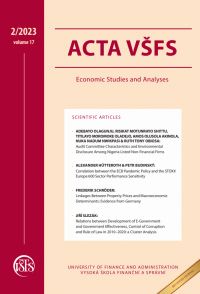Relations between Development of E-Government and Government Effectiveness, Control of Corruption and Rule of Law in 2010–2020: a Cluster Analysis
Relations between Development of E-Government and Government Effectiveness, Control of Corruption and Rule of Law in 2010–2020: a Cluster Analysis
Author(s): Jiří SlezákSubject(s): Economy, ICT Information and Communications Technologies
Published by: Vysoká škola finanční a správní, a.s.
Keywords: digitization; governance indicators; cluster analysis; e-government development index; European Union countries; public administration
Summary/Abstract: Nowadays, an increasing number of citizens use information and communication technologies to interact with the government, and therefore it is necessary for the public sphere to constantly innovate and meet the expectations placed on it under the pressure of an ever-changing environment. The aim of the article is to compare the progress of e-government between 2010 and 2020 in the member states of the European Union based on selected global indices of e-government development. The article examines the relationship between the E-Government Development Index (EGDI) and selected indices within the Worldwide Governance Indicators. The goal of the article is achieved through correlation and cluster analysis. The results of these countries vary from state to state. It was found that according to the level of digitization of public administration and the quality of public services, EU countries can be divided into 5 groups. However, within the monitored period, the EU states achieved progress in the field of digitization and the quality of public administration. The average value of EGDI increased by about 34% between 2010 and 2022 and the share of countries at a very high level EGDI in 2010 was approx. 11% and in 2022 even 100%. The best results in this area are achieved by the states in the north of the EU (for example, Denmark, Finland and Sweden), on the contrary, the worst results are achieved by the states in the east of the EU (for example, Bulgaria and Romania). The results also showed that countries that were in the best cluster and the worst cluster in individual years are still in those clusters.
Journal: Acta VŠFS - ekonomické studie a analýzy
- Issue Year: 17/2023
- Issue No: 2
- Page Range: 161-187
- Page Count: 27
- Language: English

